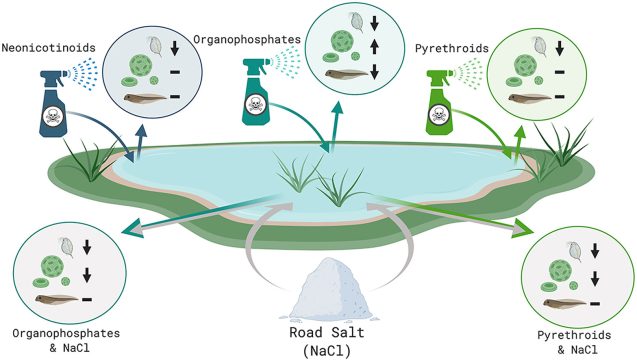07
Jan
Pesticides and Road Salt: A Toxic Mixture for Aquatic Communities

(Beyond Pesticides, January 7, 2021) Insecticides and road salts adversely interact to alter aquatic ecosystems, reducing organism abundance and size, according to a study in the journal Environmental Pollution. Pesticide use is ubiquitous, and contamination in rivers and streams is historically commonplace, containing at least one or more different chemicals. Although road salts can prevent hazardous ice formation during the colder months, the study raises critical issues regarding the adverse interaction between road salts and pervasive environmental pollutants that threaten human, animal, and environmental health and safety. Authors of the study note, “Our results highlight the importance of multiple-stressor research under natural conditions. As human activities continue to imperil freshwater systems, it is vital to move beyond single-stressor experiments that exclude potentially interactive effects of chemical contaminants.”
To assess the impact of road salts and insecticides on aquatic communities, researchers created a mesocosm (controlled outdoor experimental area) to examines the natural environment under controlled conditions. These communities include zooplankton, phytoplankton, periphyton, and leopard frog (Rana pipiens) tadpoles. Researchers performed a toxicity evaluation of six insecticides from three chemical classes (neonicotinoids: thiamethoxam, imidacloprid; organophosphates: chlorpyrifos, malathion; pyrethroids: cypermethrin, permethrin). Additionally, researchers note the potentially interactive effects of these insecticides with three concentrations of road salt (NaCl).
Researchers find that differing pesticide classes directly impact aquatic communities, and exposure to insecticides indirectly alters the food web in freshwater communities. Exposure to organophosphate decreases zooplankton abundance, elevates phytoplankton biomass, and reduces tadpole size. Neonicotinoid and pyrethroid exposure reduce zooplankton abundance, with little to no significant impact on phytoplankton abundance or tadpole size. Although the study demonstrates organophosphates decrease zooplankton abundance at all salt concentration levels, the effect on phytoplankton abundance and tadpole size depends upon salt levels. Pyrethroids, on the other hand, reduce zooplankton and phytoplankton density as salt concentrations increase.
Aquatic ecosystems are highly sensitive and complex environments. Contaminants, like pesticides, have devastating effects on the ecosystem, including non-target organisms. Furthermore, aquatic ecosystems suffer more frequent, simultaneous exposure to multiple chemical stressors. Often, these various chemical stressors work together or synergize to produce a greater, combined effect. Synergism is a common issue among pesticide mixture and can underestimate the toxic impacts on human, animal, and environmental health. Moreover, some pesticides, like the weed killer 2,4-D, have common usages on roadsides to control aquatic weeds, and mixtures of road salt and chemicals can run off into nearby water sources. Considering that the use and production of synthetic chemicals like pesticides outpace others, it is essential to understand how exposure to multiple environmental contaminants simultaneously affects normal ecosystem function.
Although pesticides and road salts individually impact aquatic communities, this study is the first to demonstrate their interactive effects. Understanding whether these interactions cause an additive, antagonistic, or synergistic effect on natural communities is necessary, especially given insecticides and road salts are commonplace in northern temperate locations. Not only do pesticides interact with NaCl (sodium chloride) road salts, but potentially other chemical salt compounds that are highly corrosive and toxic to aquatic organisms. Moreover, some road salts contain additives like sodium hexacyanoferrate(II) and sugar, and their interactive effects with pesticides lack proper research. The authors of the study suggest, “It is important to know the concentrations and type of road salt (e.g., NaCl, CaCl2, KCl, MgCl2) and pesticides that matter, the underlying mechanisms that cause the interaction, and the short- and long-term impacts of prolonged exposure.”
As the use of road salts increases throughout the winter season, it is essential to understand the impacts of interactions with other environmental pollutants, especially in contaminated ecosystems like waterways. Beyond Pesticides has long advocated for federal regulation that considers potential synergistic and additive threats to ecosystems and organisms. Moreover, pesticide use should be phased out and ultimately eliminated to protect the nation’s and world’s waterways and reduce the number of pesticides that make their way into your drinking water. Replacing pesticides with organic, non-toxic alternatives is crucial for safeguarding public health, particularly communities vulnerable to pesticide toxicity.
Furthermore, using eco-friendly alternatives to traditional road salts (i.e., pickle juice brine; organic salt-free deicer; alfalfa meal; sugar beet juice; sand, ash from the fireplace or coffee grinds; white vinegar and water) can help mitigate the impact of synergism between salts and pesticides. For more information about pesticide contamination in water, see the Threatened Waters program page and Beyond Pesticides’ article Pesticides in My Drinking Water? Individual Precautionary Measures and Community Action. Tell the U.S. Environmental Protection Agency that it must do its job to protect health and the environment.
All unattributed positions and opinions in this piece are those of Beyond Pesticides.
Source: Environmental Pollution










